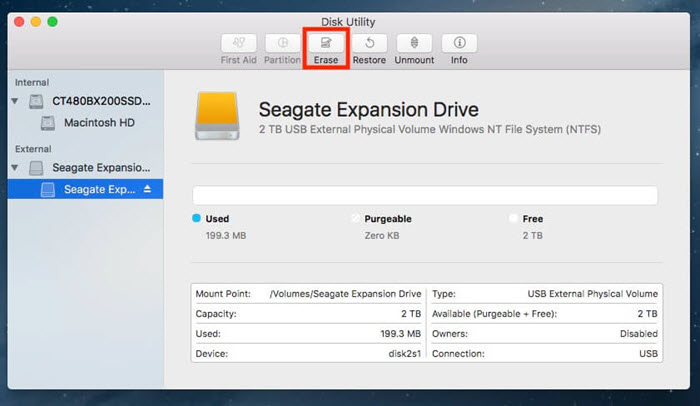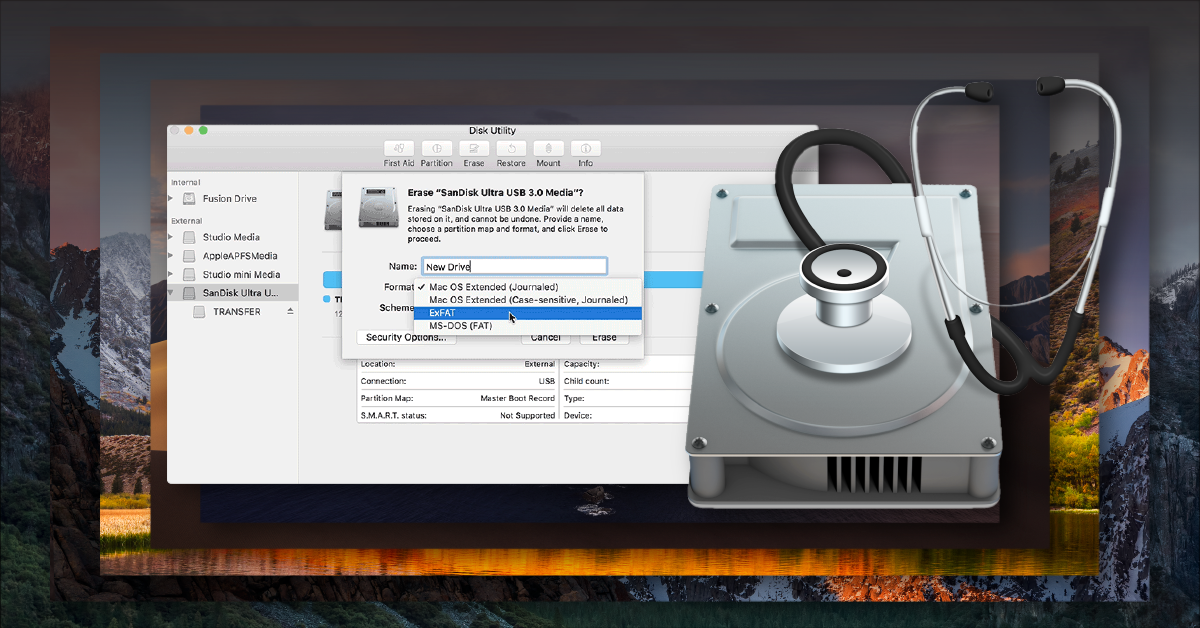Macos Hard Drive Format
When you have the need to format a hard drive under macOS 10.13 High Sierra, it typically requires the use of third-party hard drive format software like Disk Utility. In this article, we will introduce you a few tools you can use for formatting hard drive under macOS 10.13 High Sierra. First of all, get your data backed up before do the format. Now, let's start to format a hard drive under macOS 10.13 High Sierra with some easy tools.
Instructions for how to format your external drive so that it will be fully usable in MacOS. These steps can be used for both internal and external drives. Note: Reformatting the drive will erase all data on the drive, so you should copy any data you want off the drive prior to formatting. The following is based on the latest version of macOS. Select the drive you want to format from the left-hand navigation menu. Click Erase in the bottom right-hand corner. Select a file system to format the drive with. If you're not sure, Mac OS Extended (Journaled) is a safe bet.
Solution 1: format hard drive under macOS 10.13 High Sierra with Disk Utility
- It is advised not to change the default format of a Mac hard drive under any circumstances. You can check the format of a drive inside the Disk Utility Menu bar. Just click on the Get Info option and you’ll know the current format a drive is using to store files. Open the System information and select the storage.
- Launch Disk Utility and then click to select the external hard drive listed on the left. Click the 'Erase' tab, choose a volume format from the drop-down menu and then type a name for the drive. The Mac OS X Extended volume format is optimal for Macs; the Journaled option.
Step 1: Open Disk Utility
Open Finder > Applications > Utilities > Disk Utility
Step 2: Select the hard drive on the left.
Note: If you don't see two passages filed at that point change the view in plate utility to demonstrate the drive and the volume. The view catch is in the upper left-hand side, change to Show All gadgets. This component was presented in macOS 10.13 High Sierra
Step 3: Select ‘Erase ‘ which opens the accompanying window.
Step 4: Rename the drive
Step 5: Select OS X Extended (Journaled) for Format
Step 6: Select GUID Partition Map for Scheme
Note: If you don't see the plan choice, at that point you have chosen the volume and not the drive. Tap on the view catch in the upper left-hand side, change to Show All Devices. Select the non-indented section for your Seagate drive.
Cautioning: Formatting the drive will eradicate all data on the drive, so you should duplicate any data you need off the drive before arranging.
Step 7: Select Erase once more.
Step 8: Plate Utility will begin organizing the drive.
Step 9: Once total, click done.
Please note that the formatted data on your hard drive still can be recovered by data recovery software.
Solution 2: format hard drive under macOS 10.13 High Sierra with AweCleaner for Mac
Step 1: Download and install AweCleaner for Mac on your Mac.
Step 2: Run AweCleaner for Mac to format your hard drive.
Launch AweCleaner for Mac > Click Disk Manager > Select the hard drive and click on 'Format' button.
The data formatted by AweCleaner can be recovered by data recovery software. If you want to permanently erase data on the hard drive, you can try the solution 3.
Solution 3: format and erase hard drive under macOS 10.13 High Sierra with AweEraser for Mac
AweEraser for Mac is a data erasure application. It can format your hard drive and erase all the data on your hard drive, beyond the scope of data recovery. It means the data on your hard drive will be permanently erased.
Step 1: Download and install AweEraser for Mac on your Mac.
Step 2: Launch AweEraser for Mac to format your hard drive.
Launch AweEraser for Mac > Choose mode 'Erase Hard Drive' > Select your hard drive > Click on 'Erase' button. Then AweEraser for Mac will format your hard drive and permanently erase all data on the hard drive. The erased data will be lost forever.
Related Articles
© Thanayu Jongwattanasilkul / EyeEm/Getty Images You can format a hard drive on a PC or Mac using utility features. Thanayu Jongwattanasilkul /EyeEm/Getty Images- You may need to format a hard drive to match your computer's operating system before you can use it.
- To format a hard drive in Windows, you'll use the Disk Management utility; on a Mac, you'll use Disk Utility.
- Visit Business Insider's Tech Reference library for more stories.
If you're adding a hard drive to your computer, you probably need to format it to your computer's operating system before you can use it.
This is easy to do with built-in utilities for both Windows and Mac computers, and the process is the same whether you're formatting an internal drive installed on a desktop PC or an external drive plugged into your desktop or laptop.
Keep in mind that when you format a hard drive, it erases all the files and it can be difficult or impossible to recover them. Be careful with this command and always make sure you are choosing the right hard drive in the formatting utility.
How to format a hard drive on Windows
1. In the Start button search box, type 'Disk Management.'
2. In the search results, select 'Create and format hard disk partitions.'
© Dave Johnson/Business Insider Find the Disk Management utility in the Start button search results. Dave Johnson/Business Insider3. In the list of hard drives, right click the drive you want to format. In the pop-up menu, choose 'Format…'
4. In the Format window, choose the file system you want to use. Usually, you'll want NTFS, which is the default for Windows. Make sure there is a check next to 'Perform a quick format.'
Gallery: 7 Ways to Keep Your Home Wi-Fi Secure (Money Talks News)

5. When you're ready to format the drive, click 'OK.'
© Dave Johnson/Business Insider You can format a drive with just a few clicks. Dave Johnson/Business InsiderIf you want to format your Windows system drive (the 'C' drive), you can't do that when Windows is running because the drive is in use. Instead, you can download Windows 10 to a USB flash drive using the Windows 10 Media Creation Tool and boot from that. Once you've booted Windows from the USB flash drive, you can format the C drive.
How to format a hard drive on a Mac
1. In the Finder menu, click 'Go' and then, in the drop-down menu, choose 'Utilities.'
2. In the Utilities folder, choose 'Disk Utility.'
Mac Os Hard Drive Formatting
3. In the pane on the left of the Disk Utility window, click the drive you want to format.
© Dave Johnson/Business Insider Select the drive you want to format and then choose “Erase.” Dave Johnson/Business Insider
4. At the top of the window, click 'Erase.'
5. In the pop-up window, choose the file system you want to use. Usually, you'll want ExFAT, which is the default for the MacOS.
6. When you're ready, click 'Erase.'
If you want to format your Mac's system drive, you can't do that when the Mac is running normally because the drive is in use by the operating system. To get around that problem, hold down the Command + R keys when you turn on your Mac and let go when the logo appears. You'll see the MacOS Utilities window; choose 'Disk Utility.' Now you can choose to erase your startup drive, and choose 'Mac OS Extended (Journaled)' as the operating system.